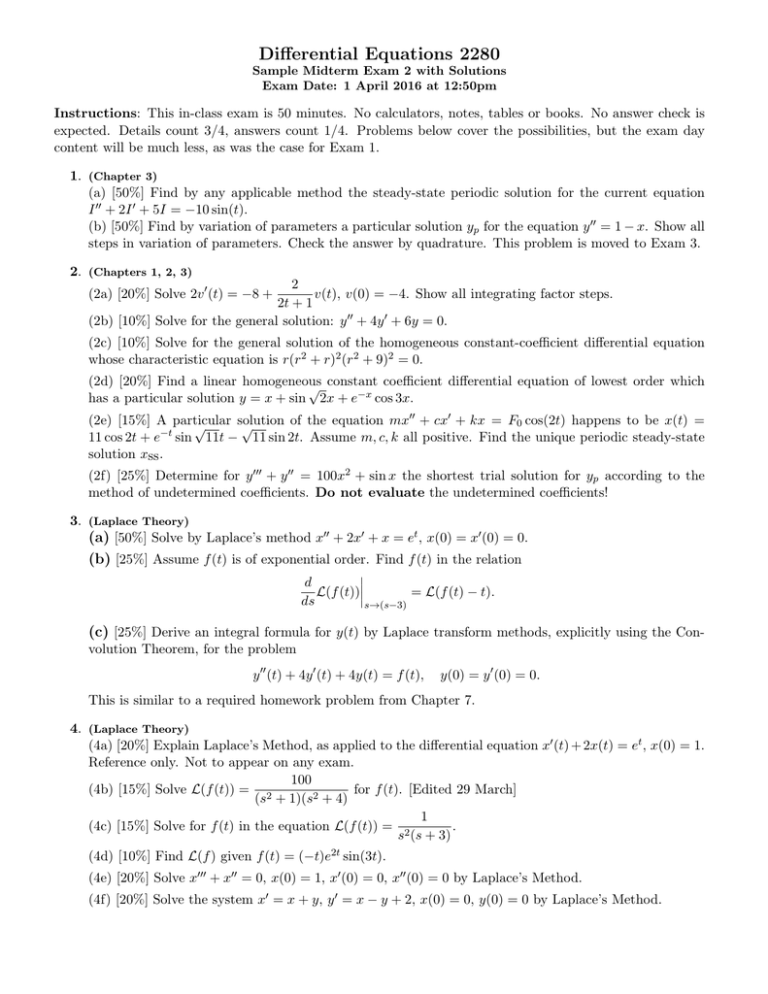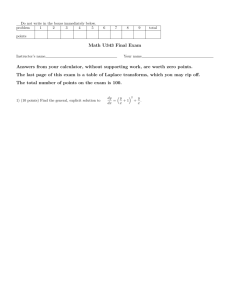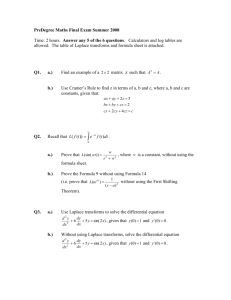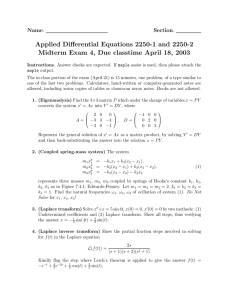Differential Equations 2280
advertisement

Differential Equations 2280 Sample Midterm Exam 2 with Solutions Exam Date: 1 April 2016 at 12:50pm Instructions: This in-class exam is 50 minutes. No calculators, notes, tables or books. No answer check is expected. Details count 3/4, answers count 1/4. Problems below cover the possibilities, but the exam day content will be much less, as was the case for Exam 1. 1. (Chapter 3) (a) [50%] Find by any applicable method the steady-state periodic solution for the current equation I 00 + 2I 0 + 5I = −10 sin(t). (b) [50%] Find by variation of parameters a particular solution yp for the equation y 00 = 1 − x. Show all steps in variation of parameters. Check the answer by quadrature. This problem is moved to Exam 3. 2. (Chapters 1, 2, 3) 2 v(t), v(0) = −4. Show all integrating factor steps. 2t + 1 (2b) [10%] Solve for the general solution: y 00 + 4y 0 + 6y = 0. (2a) [20%] Solve 2v 0 (t) = −8 + (2c) [10%] Solve for the general solution of the homogeneous constant-coefficient differential equation whose characteristic equation is r(r2 + r)2 (r2 + 9)2 = 0. (2d) [20%] Find a linear homogeneous coefficient differential equation of lowest order which √ constant −x has a particular solution y = x + sin 2x + e cos 3x. (2e) [15%] A particular solution of the equation mx00 + cx0 + kx = F0 cos(2t) happens to be x(t) = √ √ −t 11 cos 2t + e sin 11t − 11 sin 2t. Assume m, c, k all positive. Find the unique periodic steady-state solution xss . (2f) [25%] Determine for y 000 + y 00 = 100x2 + sin x the shortest trial solution for yp according to the method of undetermined coefficients. Do not evaluate the undetermined coefficients! 3. (Laplace Theory) (a) [50%] Solve by Laplace’s method x00 + 2x0 + x = et , x(0) = x0 (0) = 0. (b) [25%] Assume f (t) is of exponential order. Find f (t) in the relation d L(f (t)) = L(f (t) − t). ds s→(s−3) (c) [25%] Derive an integral formula for y(t) by Laplace transform methods, explicitly using the Convolution Theorem, for the problem y 00 (t) + 4y 0 (t) + 4y(t) = f (t), y(0) = y 0 (0) = 0. This is similar to a required homework problem from Chapter 7. 4. (Laplace Theory) (4a) [20%] Explain Laplace’s Method, as applied to the differential equation x0 (t) + 2x(t) = et , x(0) = 1. Reference only. Not to appear on any exam. 100 (4b) [15%] Solve L(f (t)) = 2 for f (t). [Edited 29 March] (s + 1)(s2 + 4) 1 (4c) [15%] Solve for f (t) in the equation L(f (t)) = 2 . s (s + 3) (4d) [10%] Find L(f ) given f (t) = (−t)e2t sin(3t). (4e) [20%] Solve x000 + x00 = 0, x(0) = 1, x0 (0) = 0, x00 (0) = 0 by Laplace’s Method. (4f) [20%] Solve the system x0 = x + y, y 0 = x − y + 2, x(0) = 0, y(0) = 0 by Laplace’s Method. 5. (Laplace Theory) (a) [30%] Solve L(f (t)) = (s2 1 for f (t). + s)(s2 − s) s+1 . + 4s + 5 (c) [20%] Let u(t) denote the unit step. Solve for f (t) in the relation (b) [20%] Solve for f (t) in the equation L(f (t)) = L(f (t)) = s2 d L(u(t − 1) sin 2t) ds Remark: This is not a second shifting theorem problem. (d) [30%] Compute L(e2t f (t)) for et − e−t f (t) = . t 6. (Systems of Differential Equations) The eigenanalysis method says that, for a 3 × 3 system x0 = Ax, the general solution is x(t) = c1 v1 eλ1 t + c2 v2 eλ2 t + c3 v3 eλ3 t . In the solution formula, (λi , vi ), i = 1, 2, 3, is an eigenpair of A. Given 4 1 1 A = 1 4 1 , 0 0 4 then (a) [75%] Display eigenanalysis details for A. (b) [25%] Display the solution x(t) of x0 (t) = Ax(t). 5 1 1 (c) Repeat (a), (b) for the matrix A = 1 5 1 . 0 0 7 7. (Systems of Differential Equations) (a) [30%] Find the eigenvalues of the matrix A = 4 1 0 0 1 −1 0 4 −2 1 . 0 2 0 0 2 4 (b) [20%] Justify that eigenvectors of A corresponding to the eigenvalues in increasing order are the four vectors 1 −1 −1 1 −5 1 0 1 , , , . −3 0 0 0 3 0 1 0 (c) [50%] Display the general solution of u0 = Au according to the Eigenanalysis method. This is identical to the answer 8. (Systems of Differential Equations) " (a) [100%] The eigenvalues are 3, 5 for the matrix A = # 4 1 . 1 4 Display the general solution of u0 = Au according ! to the Cayley-Hamilton-Ziebur shortcut (textbook 1 . chapters 4,5). Assume initial condition ~u0 = −1




